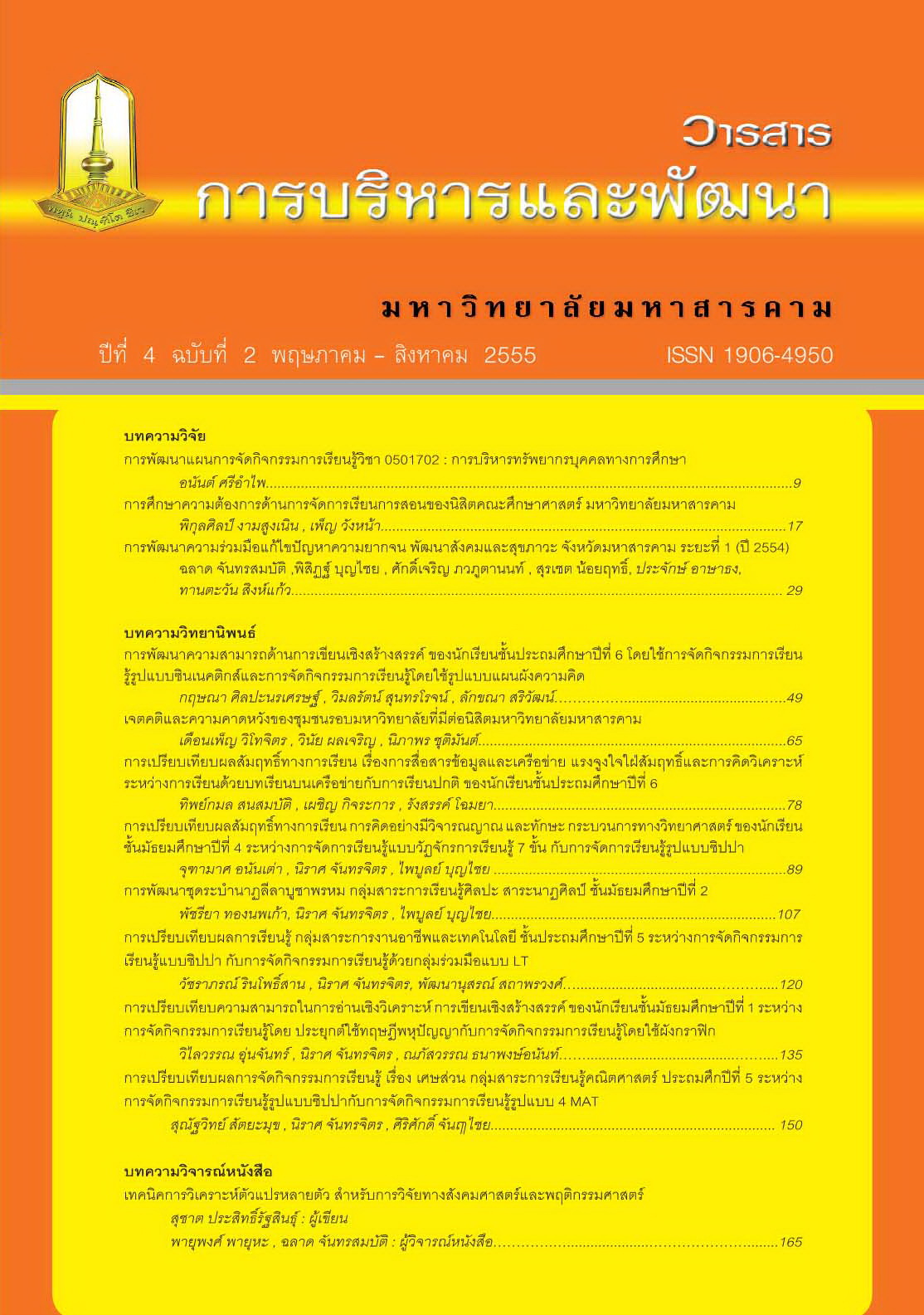การเปรียบเทียบผลการจัดกิจกรรมการเรียนรู้ เรื่อง เศษส่วน กลุ่มสาระการเรียนรู้คณิตศาสตร์ ประถมศึกปีที่ 5 ระหว่างการจัดกิจกรรมการเรียนรู้รูปแบบซิปปากับการจัดกิจกรรมการเรียนรู้รูปแบบ 4 MAT
Main Article Content
Abstract
บทคัดย่อ
การวิจัยครั้งนี้มีความมุ่งหมายเพื่อ (1) พัฒนาแผนการจัดกิจกรรมการเรียนรู้ด้วยรูปแบบซิปปา และการจัดกิจกรรมการเรียนรู้ด้วยรูปแบบ 4MAT เรื่อง เศษส่วน ชั้นประถมศึกษาปีที่ 5 ที่มีประสิทธิภาพตามเกณฑ์75/75 (2) หาดัชนีประสิทธิผลของแผนการจัดกิจกรรมการเรียนรู้ด้วยรูป แบบซิปปาและการจัดกิจกรรมการเรียนรู้ด้วยรูปแบบ 4MAT เรื่อง เศษส่วน ชั้นประถมศึกษาปีที่ 5 (3) เปรียบเทียบผลสัมฤทธิ์ทางการเรียน ความสามารถการให้เหตุผล และความสามารถการเชื่อมโยงทางคณิตศาสตร์ของนักเรียนชั้นประถมศึกษาปีที่ 5 ระหว่างกลุ่มที่จัดกิจกรรมการเรียนรู้ด้วย รูปแบบซิปปาและรูปแบบ4MAT กลุ่มตัวอย่าง ได้แก่นักเรียนชั้นประถมศึกษาปีที่5 ห้อง5/1 และ ห้อง 5/2 โรงเรียนบ้านหนองเชียงซุย อำเภอบ้านฝาง สังกัดสำนักงานเขตพื้นที่การศึกษาขอนแก่น เขต 1 จำนวน 2 ห้อง ๆ ละ 22 คน ซึ่งได้มาโดยการสุ่มแบบกลุ่ม (Cluster Random Sampling) โดยจับสลากได้นักเรียนชั้นประถมศึกษา ปีที่ 5/1 เป็นกลุ่มที่จัดกิจกรรมการเรียนรู้รูปแบบซิปปา และชั้นประถมศึกษาปีที่ 5/2 เป็นกลุ่มที่จัดกิจกรรมการเรียนรู้รูปแบบ 4MAT เครื่องมือที่ใช้ในการวิจัยได้แก่ (1) แผนการจัดกิจกรรมการเรียนรู้แบบซิปปา และแผนการจัดกิจกรรมการเรียนรู้รูปแบบ 4MAT จำนวนรูปแบบละ 10 แผน รวมเวลารูปแบบละ 20 ชั่วโมง (2) แบบทดสอบวัดผลสัมฤทธิ์ทางการเรียนชนิดปรนัยเลือกตอบ 4 ตัวเลือก จำนวน 30 ข้อ (3) แบบทดสอบวัดความสามารถการให้เหตุผล ชนิดปรนัยเลือกตอบ 4 ตัวเลือก จำนวน 25 ข้อ และ (4) แบบทดสอบวัดความสามารถ การเชื่อมโยงทางคณิตศาสตร์ชนิดปรนัยเลือกตอบ 4 ตัวเลือก จำนวน 25 ข้อ สถิติที่ใช้ในการวิเคราะห์ข้อมล ได้แก่ ค่าเฉลี่ย ร้อยละ ส่วนเบี่ยงเบนมาตรฐาน และการทดสอบสมมติฐานใช้ Hotelling’s Trace
ผลการวิจัยปรากฏ ดังนี้
1. แผนการจัดกิจกรรมการเรยนรู้ด้วยรูปแบบซิปปาและกิจกรรมการเรียนรู้ด้วยรูปแบบ 4MAT เรื่อง เศษส่วน ชั้นประถมศึกษาปีที่ 5 มีประสิทธิภาพเท่ากับ 81.24/80.76 และ 78.58/75.30 ตามลำดับ
2. ดัชนีประสิทธิผลของแผนการจัดกิจกรรมการเรียนรู้ด้วยรูปแบบซิปปา และแผนการจัดกิจกรรมการเรียนรู้ด้วยรูปแบบ 4MAT เรื่อง เศษส่วน ชั้นประถมศึกษาปีที่ 5 มีค่าเท่ากับ 0.7239 และ0.6321 ตามลำดับ
3. นักเรียนชั้นประถมศึกษาปีที่ 5 กลุ่มที่ได้รับการจัดกิจกรรมการเรียนรู้ด้วยรูปแบบซิปปา มีผลสัมฤทธิ์ทางการเรียนสูงกว่า แต่มีความสามารถการให้เหตุผลน้อยกว่ากลุ่มที่ได้รับการจัดกิจกรรมการเรียนรู้ด้วยรูปแบบ 4MAT อย่างมีนัยสำคัญทางสถิติที่ระดับ .01 และนักเรียนทั้งสองกลุ่มมีความสามารถการเชื่อมโยงทางคณิตศาสตร์หลังเรียนไม่แตกต่างกัน
คำสำคัญ : การจัดกิจกรรมการเรียนรู้ด้วยรูปแบบซิปปา, การจัดกิจกรรมการเรียนรู้ด้วยรูปแบบ 4MAT, ผลสัมฤทธิ์ทางการเรียน, ความสามารถการให้เหตุผล, ความสามารถการเชื่อมโยงทางคณิตศาสตร์
ABSTRACT
The purposes of this study were: to find out an efficiency and an effectiveness index of the plans for organization of the CIPPA Model and 4MAT Learning Model; to compare learning achievement, mathematical reasoning, and mathematical connections abilities of prathomsuksa 5 students who learned using different learning approaches. The sample used in this study consisted of 44 Prathyomsuksa 5 students attending Ban Nong-Siang Sui school in Ban Fang district, Khon Kaen Province in the first semester of the academic year 2009, obtained using the cluster random sampling technique. They were randomly divided two experimental groups, 22 students each in which the classroom group 5/1 learned the organization of the CIPPA model and group 5/2 learned 4MAT learning model. The instruments used for the study comprised of: (1) two types of plans for organization the CIPPA Model and 4MAT Learning Model, 10 plans each, for 2 hours per plan ; (2) a 30-item of learning achievement test; (3) a 25-item of mathematical reasoning ability test; and (4) a 25-item of mathematical connection ability test. The statistics used for analyzing data were percentage, mean, standard deviation, and for testing hypothesis the Hotelling’s T2 was employed.
The results of the study were as follows :
1. The plans for organization of the CIPPA Model and 4MAT Learning Model had efficiencies (E /E ) of 81.24/80.76 and 78.58/75.30 respectively.
2. The plans for organization of the CIPPA Model and 4MAT Learning Model had the effectiveness indices of 0.7239 and 0.6321 respectively.
3. The students who learned using the plans for organization of the CIPPA model showed higher learning achievement, but showed lower mathematical reasoning abilities than who learned using the 4MAT learning model (p< .01), and the students who learned both of those approaches did not statistically show different of mathematical connection abilities.
Keyword: organization of the CIPPA model, the 4MAT learning model, learning Achievement, mathematical reasoning abilities, mathematical connection Abilities

